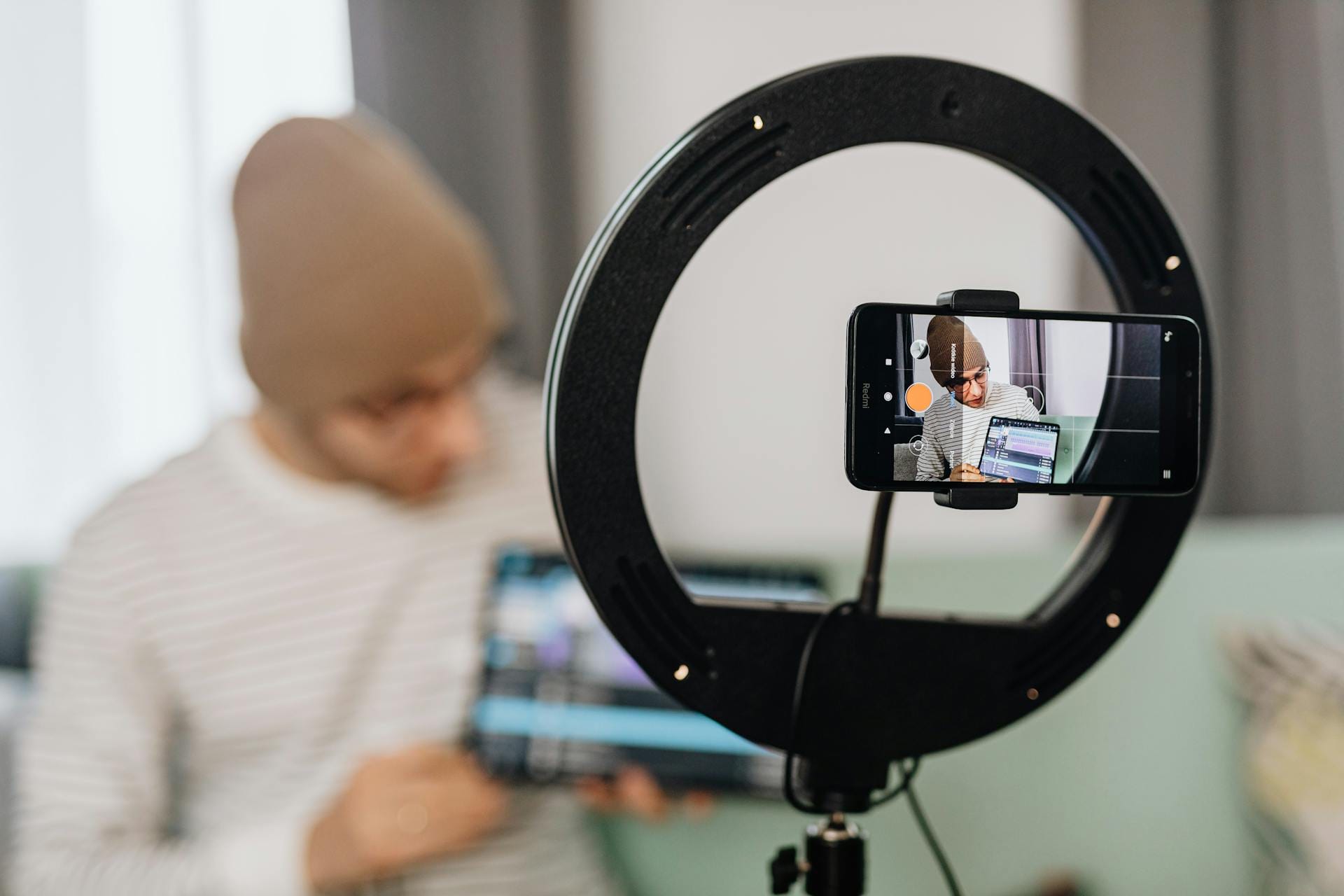
How a $100,000 sales page is made
Back in December, IWT or I Will Teach You To Be Rich launched a new course called Teach Yourself Anything. We did it with a five-day email sequence and a 5,000-word sales page. Even though we launched it quietly — no webinar, no three-week buildup — this $199 product made more than six figures in less than a week.
Before I joined the product team here at IWT, I always used to look at those massive sales pages in awe and think, “HOW did they do that!?” Does our CEO Ramit Sethi do it all himself? How does one get so many readers to want the product?
A few months ago, I got to be a fly-on-the-wall during our entire sales page writing process for a new product we’re creating. I observed and took notes on everything — from how our writers brainstorm and outline, to how Ramit labors over a single paragraph until it hits the perfect emotional chord.
Like a good sales page, IWT’s writing process has a beginning, middle, and end. I pulled one game-changing insight for each phase — each one helping us build a closer connection and making an emotional connection with the reader.
#1: Getting started: Talk to real humans before you ever write a single word
#2: Come up with more ideas than you need
#3: The final edit: Use the “Guilt Trip Test” to identify powerful, emotional copy
These insights have helped me immensely in my own writing process — and will hopefully help yours too.
#1: Getting started: Talk to real humans before you ever write a single word
One of the scariest parts about writing a sales page is knowing where to start. But if we’ve done our job, 80% of the work has been done way ahead of time.
When our copywriters are ready to write a sales page, they don’t just stare at a blank page until they come up with something. The first thing they do is pull up the Positioning Document.
This document, created by our product development team during our initial research phase, is a summary of the insights we’ve gathered from customer surveys, 1-on-1 customer research calls, and competitive research.
It tells us:
- Who our customer is
- Their hopes, fears, pains, and dreams
- The primary problem our customer has
- How our product solves that problem
- What they’ve already tried to solve this problem
- What makes this product different or better than its competitors
This is put together by reading customer emails, survey responses, and doing 1-on-1 calls with customers. (You ARE doing all of this research before making a product, right?) Any time we notice a pattern, we include it in the Positioning Document. It should give our writers everything they need to know to sell the product to the right customer.
Here’s an excerpt of the Positioning Document for our course, Teach Yourself Anything: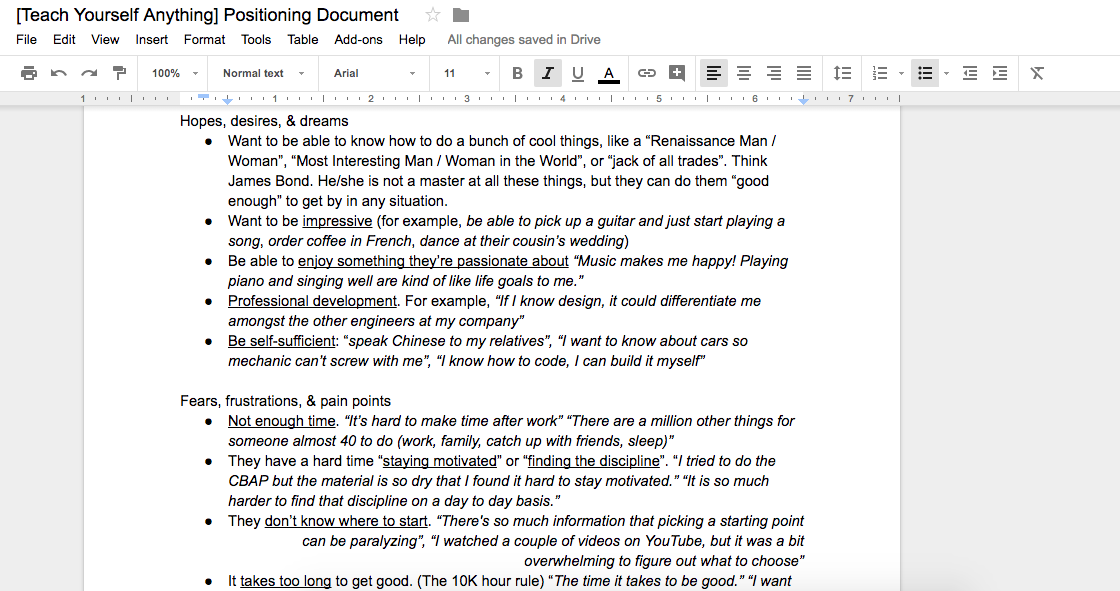
Excerpt from the Positioning Document
Our copywriter will go through this document and highlight any “nuggets” that strike him as useful for the basis of our sales copy. The key things he’s looking for are:
- Our customers’ hopes, fears, pains, and dreams
- The primary problem our product is solving for them
- What our customers have done to try to solve this problem
These insights help us build trust with our reader by showing them we deeply understand what they’re going through. If we take a look at the above excerpt of the Positioning Document, we see things that tell us about our customers’ hopes, fears, pains, and dreams:
- Get by in any situation: “Dance at my cousin’s wedding,” “Order coffee in French”
- Professional development: “If I know design, it could differentiate me amongst the other engineers at my company”
- Be able to enjoy something they’re passionate about: “Music makes me happy! Playing piano and singing well are kind of like life goals to me”
- “It’s hard to make time after work”
- “There are a million other things for a person over 40 to do”
- “It is so much harder to find that discipline on a day-to-day basis”
- “There’s so much information that picking a starting point can be paralyzing”
A lot of these are direct quotes taken from our interviews and surveys with potential customers. All of this is helpful in writing sales copy because now we know exactly who we’re talking to.
Our copywriter will grab those nuggets and start brainstorming ideas for the first draft of the sales page.
Notice how those quotes end up getting directly addressed in the sales page draft: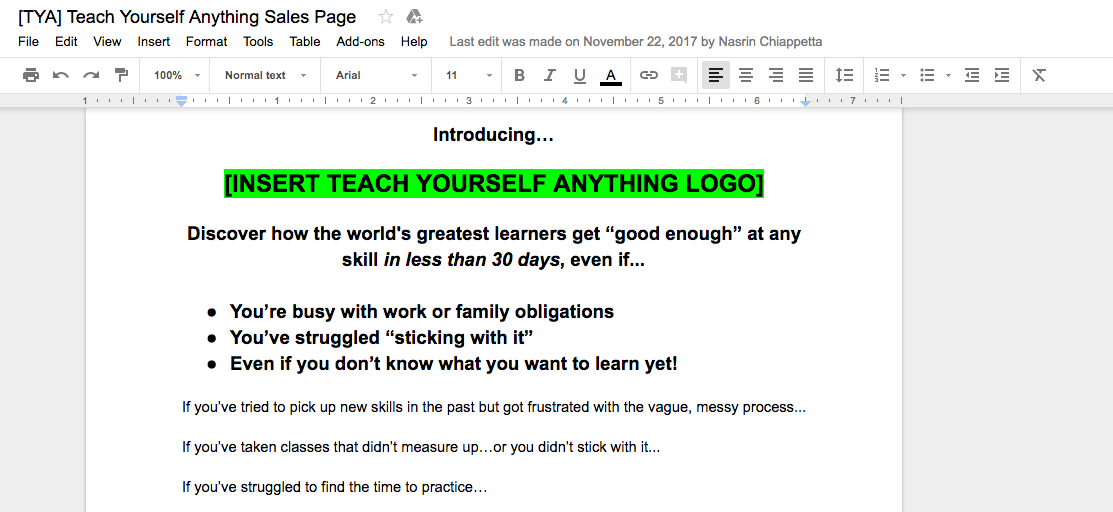
Addressing quotes straight from the customer research:
“It’s hard to make time after work”
“It is so much harder to find that discipline”
“Picking a starting point can be paralyzing”
THIS is how you can write emotional copy even if you aren’t a seasoned copywriter. Talk to real humans, write down their direct quotes, and use it directly in your copy.
#2: Come up with more ideas than you need
The Positioning Document helps us address our readers’ pains, fears, hopes, and dreams. We use those to write the first half of the sales page, where we build desire for the product. That’s where we spend most of our time. Then the second half is more straightforward because it’s all about the product.
However, there is one part of this section that we spend a lot of time on.
And that’s the bullets, or “fascinations.”
They’re sometimes referred to as “fascinations” in the copywriting industry because they should evoke deep desire and curiosity about the product or service they’re selling.
The fascinations give the readers a sneak peek at what’s inside the product.
They aim to get the reader FASCINATED with what’s in the product. You’ve seen them: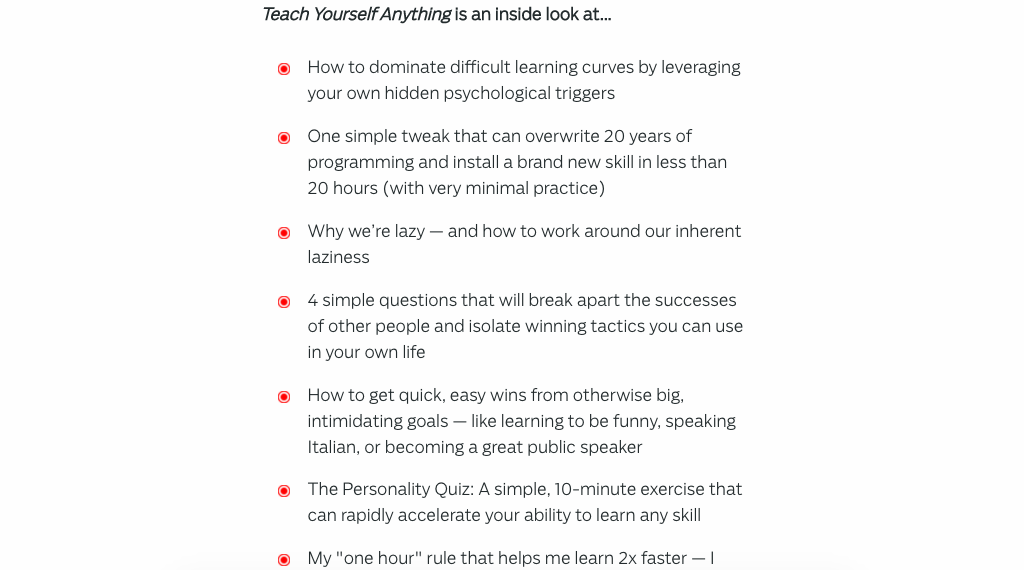
Fascinations on our final sales page
How do we come up with those? Well, our copywriter goes through transcripts from our course videos for interesting stories, techniques, benefits, and features that he can use to describe the product.
Let’s take a look at a script from our Teach Yourself Anything content, a video about “The Art of Learning Things in Your Spare Time.” (Note: Our internal codename for this project was “LAF.”):

Want to build a business that enables you to live YOUR Rich Life? Get my FREE guide on finding your first profitable idea.
Our copywriter has gone through it and left a bunch of comments. What he’s doing is identifying exciting, interesting ways to describe the benefits and features from this video. He’ll pull out those comments and brainstorm as many bullets he can think of.
Remember, the Positioning Document helps us understand our CUSTOMER. It tells us what their hopes, fears, pains, and dreams are so that we can make sure our product is positioned as the right solution to their problems. The Content Outline is all about the PRODUCT. It tells our customer what features and benefits they get from the program.
Take a look at the script above. How many different ways do you think you could make the reader want to see what’s in this video? Here are the ideas we came up with for this video alone:
- Why you don’t need to “get serious” or change your priorities when you want to learn something new
- How to practice/learn something new when it’s not a priority
- How to get in five hours of practice a month without adding anything to your calendar
- The Stacking Technique — use this to learn a new language without changing the way you spend your time
- How to learn things while you’re doing something else
- The Stacking Technique — use this to add 10 hours of learning time per month without changing up your daily routine
- How to become astoundingly good without “making room” for practice
Seven ideas for this video alone! And we’ve got 14 more videos to go.
Notice that each is working hard to evoke curiosity in the product. The great part about this process is that it ensures that every bullet is actually answered in the course. These aren’t empty promises, these are topics we actually address.
I’m reading these and thinking, “Five extra hours without adding anything to my calendar? What’s this Stacking Technique? I need to know that! Not having to change my priorities? Yes, please.”
Most of these bullets will be completely scrapped, and that’s OK. The goal is to get as many ideas on paper, pick the strongest, sharpen them, and boom! We’ve got mouth-watering bullets.
From that long list of seven ideas, here’s what we decided was the strongest:
- The Stacking Technique: Use this to add 10 hours of learning time per month without changing up your daily routine
It has an intriguing name. It’s measurable — 10 hours of learning per month. And it’s counterintuitive — most people don’t think you could add 10 hours of anything without having to change up your routine. That’s why it was a winner.
We’ll do the same thing for all of our product content, starting with a long list of over 50 bullet ideas…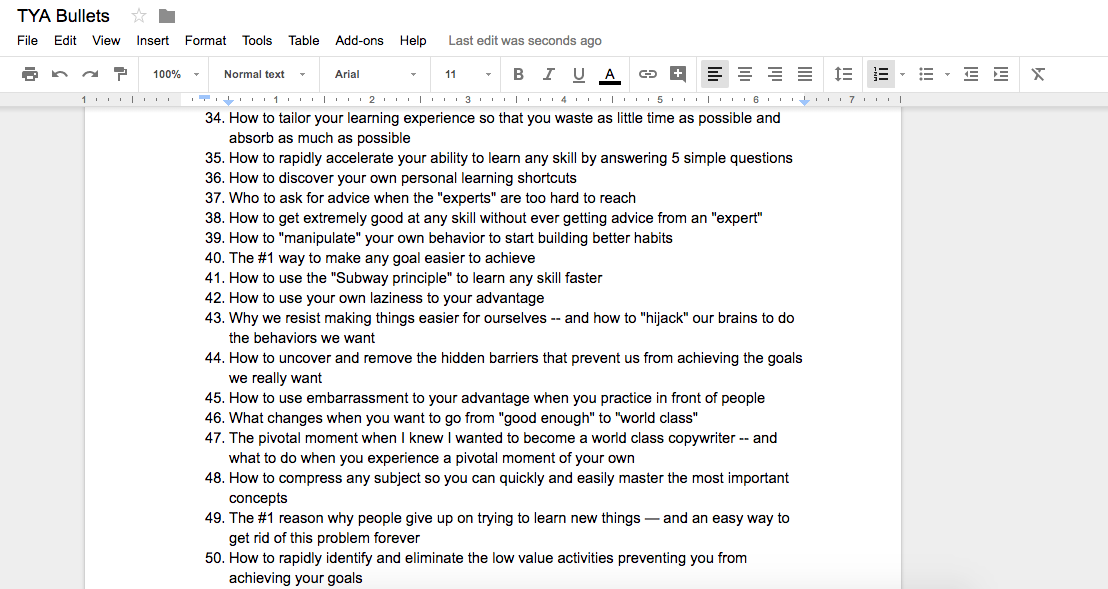
Once we have 15 to 20 winners, we’ll add them to the sales page: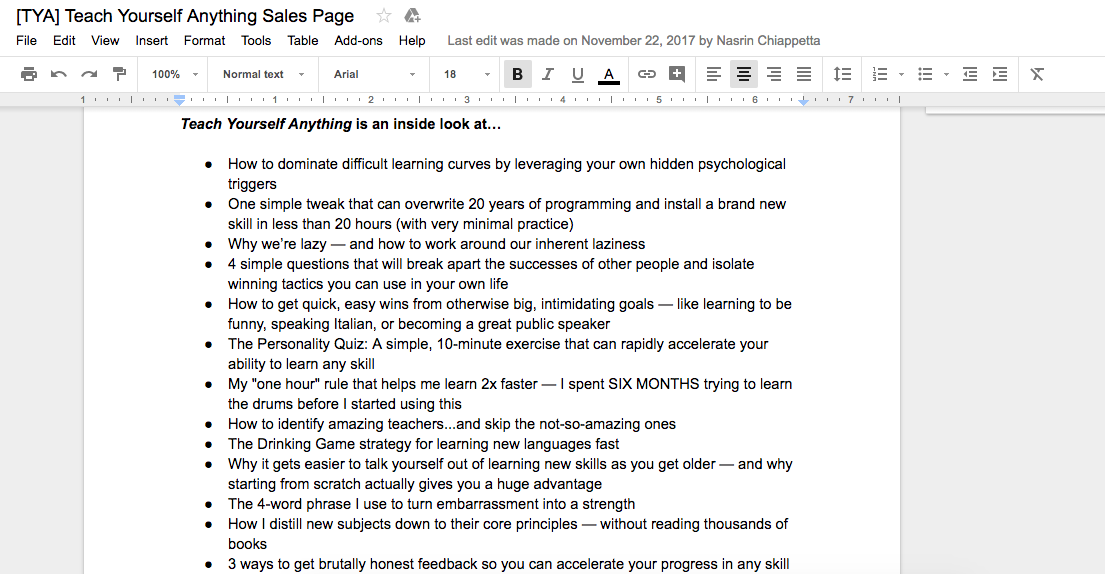
I love this about our copywriting team. If someone tells me, “you need 15 bullets,” I’ll sit there spinning my wheels until I’ve crafted 15 perfect bullets — no more. But one of the keys to being a great copywriter is being able to come up with a TON of ideas.
Then you can step back and pick the best ones.
If you don’t have a team to help you review the bullets, you can show them to a few friends and ask them which ones stand out to them the most.
#3: The final edit: Use the “Guilt Trip Test” to identify powerful, emotional copy
Once we got a good version going, it’s time to edit edit edit. After drafting a full sales page, our copywriter gets it in front of Ramit Sethi, our CEO, and Ryan Johnson, our director of editorial, for review and editing.
I got a chance to watch Ramit review the first draft. One thing that stood out to me was his ability to find that ONE sentence, that ONE powerful idea that will blow up the entire sales page. The thing that will take it from “good” to AMAZING. He does this by applying the “Guilt Trip Test.”
Ramit’s first step is to read through the entire thing. He’s not making any line edits at this point — he’s just noticing how it makes him FEEL.
For example, take a look at this section of the Teach Yourself Anything first draft. He saw this ONE sentence buried deep on page five of the sales page copy, “How many of us seem to ‘freeze’ at 25 and stop learning or trying anything new?”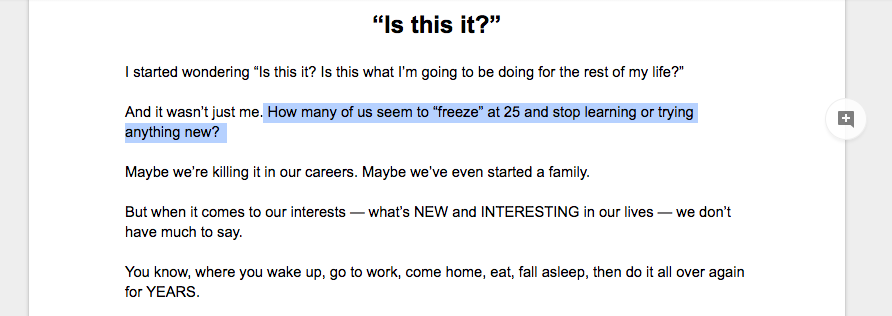
Page 5 of the first draft of the Teach Yourself Anything sales page
Ramit specifically called this sentence out as “powerful.”
How does he know that?
Whenever he reads something that makes him feel guilty — like, “Oh my god, I’ve totally thought that myself” — or fearful, or excited, he knows we’re onto something.
He found this part about freezing at 25 powerful because it’s REAL. Think about it. So many of us go out and try cool new things when we’re young. Then we get older, we “settle down,” and the next thing you know? We’re sitting at home every night watching Netflix.
It unearthed a real fear for him about being boring after age 25. In other words, this sentence passed the Guilt Trip Test.
So he took that one buried sentence, blew it up with a personal story, and turned it into the entire 300-word introduction for the Teach Yourself Anything sales page:
A few years ago, my friend and I were grabbing drinks in the East Village. “What have you been up to?” he asked as I pulled up a stool. I’d just come back from a museum tour after breakfast with some CEO friends.
He drank his beer. “You remind me of me when I was single.”
“Yeah?” I asked. I wasn’t sure what he meant.
“I used to do a bunch of interesting things around the city … but once you get in a relationship, it kinda changes.”
At the time, it felt good to hear. Yeah, I knew all the cool NYC things to do!
But a few years later, I found myself in exactly the same situation as my friend:
- Same bars
- Same conversations
- Same weekend plans
In fact, when someone asked me “What’d you do this weekend?” my response was… “Nothing really.”
Or: “Same old.”
Or even worse: “Just worked.”
Oh god. Suddenly, I didn’t feel so cool. I was starting to realize how people get stuck in a rut.
(Also, how easy it is to bury yourself in work as an excuse, a shield against trying new things. “Sorry, I can’t go out tonight … I’m working.”)
I started wondering, “Is this it? Is this what I’m going to be doing for the rest of my life?” Already knowing exactly what I was going to do every weekend. Going out to beers once every couple weekends. Ho hum.
And it wasn’t just me. How many of us seem to “freeze” at 25 and stop trying anything new?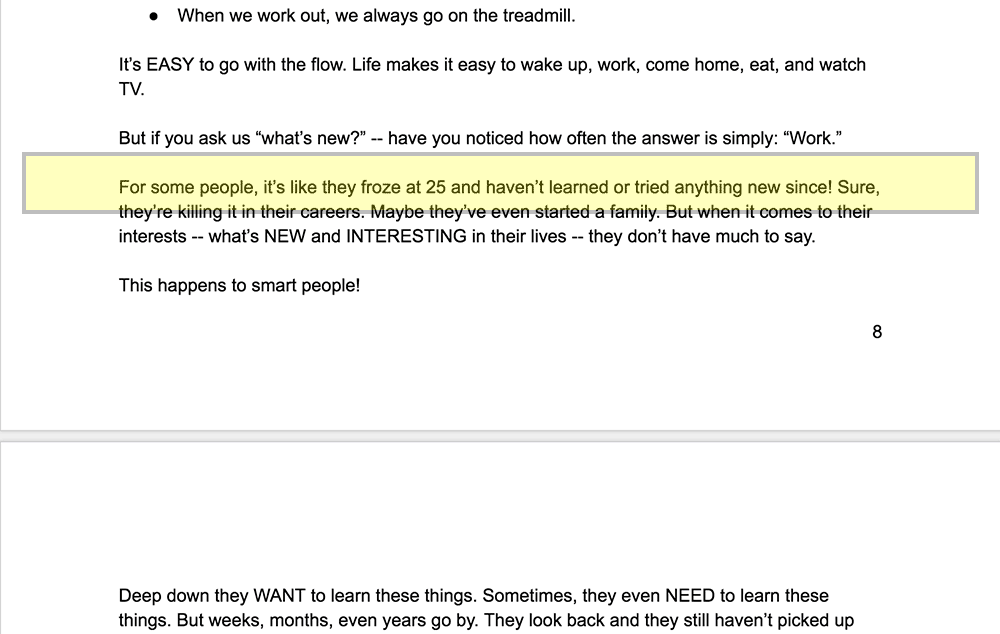
The key takeaway here is, after you draft your copy, read through it. If you find something that makes you really FEEL something — guilty, afraid, or even excited — don’t let it sit buried in some skimmable paragraph. Take a step back and ask yourself, “How can I go deeper here?” If you’re not the emotional type, ask a few friends to read through your copy and call out passages that strike an emotional chord with them.
Ignore all feedback at this stage about length, typos, or whether or not they like your Boyz II Men reference. It’s the emotion that you need to get right before you worry about anything else.
The final sales page
Here’s what the final sales page ended up looking like.
So, what do we take away from my sales page voyeurism?
You can’t even begin to talk about your product if you haven’t met your customer where they are. They need to know that you deeply understand their problem. You can do that by:
- Talking to your customers — getting on the phone with REAL people — and taking note of the exact quotes they use to describe their pains, fears, hopes, and dreams.
- Coming up with at least 3x more ideas than you need — then picking the best.
- Taking an “emotional” pass through your copy to find any quotes, sentences, or concepts that make you feel like you’ve stumbled upon an unspoken truth. Ask yourself, “How can I talk about this even more?”
Going through this process has given me lots of takeaways that will help me immensely with my writing process on and off the sales page. I even used them to write this post!
Now I want to hear from you. What’s ONE new thing you can implement in your sales page writing process now to make more of an emotional connection with your reader?
If you want to learn more about the process, later this year keep an eye out for a new course that shows our exact behind-the-scenes process to writing a six-figure sales page.



